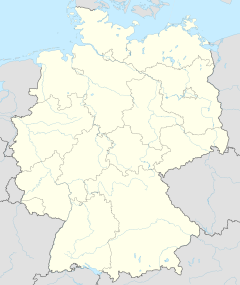Belvedere auf dem Pfingstberg
| Belvedere on the Pfingstberg | |
|---|---|
| Belvedere auf dem Pfingstberg | |

The Belvedere on the Pfingstberg
|
|
|
Location in Germany
|
|
| General information | |
| Type | Palace, viewing structure |
| Architectural style | Renaissance Revival |
| Town or city | Potsdam |
| Country | Germany |
| Groundbreaking | 1847 |
| Completed | 1863 |
| Renovated | 1988-2005 |
| Landlord | Stiftung Preussische Schlösser und Gärten |
| Design and construction | |
| Architect |
Ludwig Persius, Friedrich August Stüler, Ludwig Ferdinand Hesse, Peter Joseph Lenné (gardens) |
| Website | |
| Stiftung Preußische Schlösser und Gärten | |
| UNESCO World Heritage Site | |
| Official name | Palaces and Parks of Potsdam and Berlin |
| Criteria | Cultural: (i), (ii), (iv) |
| Reference | 532 |
| Inscription | 1990 (14th Session) |
| Extensions | 1992, 1999 |
|
[]
|
|
The Belvedere on the Pfingstberg (German: Belvedere auf dem Pfingstberg) is a large structure north of the New Garden in Potsdam, Germany, at the summit of Pfingstberg hill. It was commissioned by King Friedrich Wilhelm IV of Prussia and built between 1847 and 1863 as a viewing platform.
The Belvedere forms part of the UNESCO World Heritage Site Palaces and Parks of Potsdam and Berlin, inscribed in 1999.
It was commissioned by King Friedrich Wilhelm IV of Prussia and as completed is only part of a substantially more extensive project for the hilltop site. The Belvedere was built, as its name suggests, as a viewing platform for visitors and contains only two modest scale rooms for entertainment, one in each upper tower. The mural decoration of these (Roman-Etruscan and Moorish, respectively) is mostly now lost.
Architecturally eclectic, the two towers are modelled on Italian Renaissance architecture whilst the wings are Roman in style and some of the detailed decoration is Greek-inspired. It was constructed between 1847 and 1863 with an interruption from 1852 to 1860.
Based on sketches from the King, the architects Ludwig Persius, Friedrich August Stüler and Ludwig Ferdinand Hesse drew detailed plans. The landscape architect Peter Joseph Lenné was responsible for the design of the grounds which are planted in the manner of the English landscape garden with serpentine paths and dense copses of hardwood trees. These now obstruct views of the Belvedere from the park and almost all points in Potsdam, but are apparently as designed by Lenné.
...
Wikipedia

